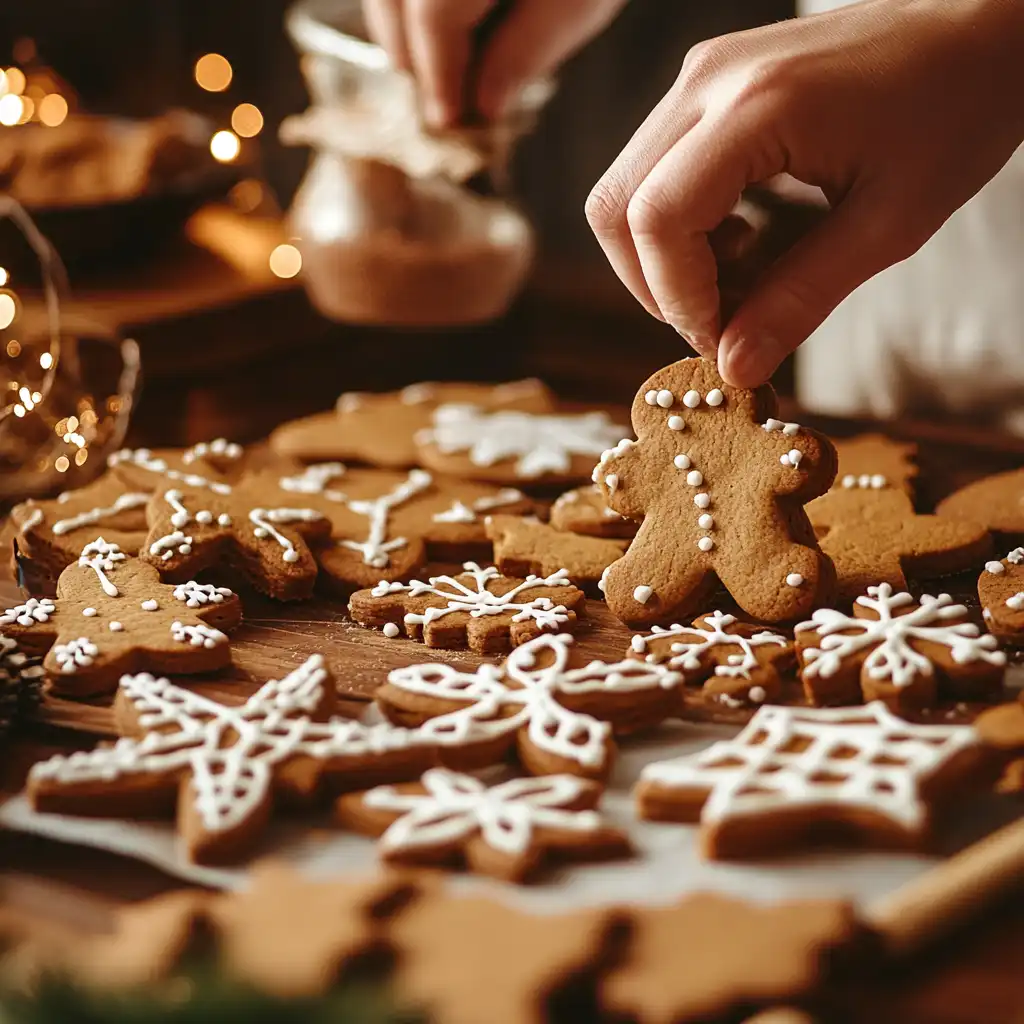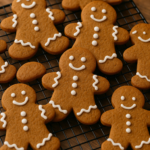When we think about Christmas, cookies often come to mind—whether it’s decorating gingerbread men, enjoying sugar cookies, or nibbling on a warm batch of spiced treats. But have you ever wondered which oldest Christmas cookies have stood the test of time? These oldest Christmas cookies have been enjoyed for generations and have become a staple of holiday celebrations. They hold a special place in our kitchens and hearts, continuing to bring joy year after year. Join us as we explore the fascinating history of these oldest Christmas cookies, uncover the cultures they come from, and learn how to bake some of the oldest Christmas cookies yourself!
Part 1: What Are the Oldest Christmas Cookies?
The oldest Christmas cookies are generally believed to be gingerbread cookies, which have a long and rich history. These cookies, made with a blend of spices like ginger, cinnamon, and cloves, have been a part of Christmas celebrations for centuries.

The Origins of Gingerbread Cookies
Gingerbread traces its roots to ancient civilizations such as the Greeks and Egyptians, who used ginger and other spices for medicinal purposes. However, the gingerbread cookie, as we know it today, has its origins in medieval Europe. German bakers started shaping the dough into festive shapes, such as hearts, stars, and animals, during the 16th century. They used ginger, honey, and various spices to create a dough that was both flavorful and aromatic. Gingerbread often served as both a treat and decoration during Christmas celebrations.
Gingerbread was originally used as a gift. People often gave it to visitors as a token of hospitality and prosperity. Over time, it evolved into a more elaborate dessert, with intricate designs and decorations, and became a central part of Christmas traditions. The oldest Christmas cookies, made from gingerbread, became synonymous with holiday joy and togetherness.
The Popularity of Gingerbread Around Christmas
By the 17th century, gingerbread had become a beloved Christmas cookie. In fact, it wasn’t just eaten; it also served as part of Christmas decorations. Elaborate gingerbread houses, decorated with icing and candies, became a widespread tradition. These houses would often feature intricate designs and sometimes served as centerpieces for holiday feasts.
The creation of gingerbread houses became popular in Germany in the early 1800s, following the publication of the fairy tale Hansel and Gretel, in which a witch lives in a house made entirely of gingerbread. This fairy tale sparked the imagination of bakers, who began constructing gingerbread houses decorated with icing, candies, and small figures. This tradition soon spread to other countries and became a key part of Christmas celebrations.
Part 2: Other Old Christmas Cookies from Around the World
While gingerbread is perhaps the most famous oldest Christmas cookie, it’s far from the only one. Many countries have their own traditional cookies, passed down through generations and baked for centuries during the holiday season. Let’s look at some of the other beloved Christmas cookies around the world.

Lebkuchen: A German Favorite
Lebkuchen is a German cookie similar to gingerbread, but with a softer texture and a unique blend of spices. These cookies date back to the 14th century and are often shaped into hearts, stars, or rounds. The dough, flavored with honey, almonds, and spices like ginger, cinnamon, and cardamom, creates a rich, sweet flavor. They often get glazed with a sugar or chocolate coating, making them a perfect Christmas treat.
Lebkuchen holds significant cultural value in Germany, especially during the Christmas season. It’s a traditional part of Christmas markets, where vendors sell freshly baked versions of these cookies. Some regions of Germany even host Lebkuchen festivals where bakers compete to create the most beautifully decorated or uniquely flavored cookies.
Pfeffernüsse: Spicy and Sweet
Pfeffernüsse cookies, which translate to “peppernuts,” are traditional in Germany, the Netherlands, and Denmark. These small, round cookies feature a spicy combination of pepper, anise, and cloves, giving them a unique flavor. They often get dusted with powdered sugar and are particularly popular during Christmas.
Like gingerbread, Pfeffernüsse cookies are made in large batches and enjoyed throughout the holiday season. In many European households, making Pfeffernüsse cookies together is a cherished family tradition.
Biscotti: Italian Elegance in a Cookie
Although biscotti isn’t strictly a Christmas cookie, it plays a significant role in Italian holiday traditions. These twice-baked, crunchy cookies are usually flavored with almonds, hazelnuts, or other nuts and served with a warm beverage like coffee or vin santo. Italians often enjoy biscotti during Christmas dinners, making it a lovely example of how different cultures celebrate the season with their own distinct cookies.
In southern Italy, it’s a common tradition to bake various flavors of biscotti and share them with family and friends. The crispy texture and nutty flavor of biscotti make it an ideal accompaniment to festive meals and gatherings.
Part 3: Why Do We Bake Cookies at Christmas?
Baking oldest Christmas cookies has become a cherished tradition for many families. There are several reasons why cookies play such an important role during Christmas.
A Symbol of Holiday Warmth
Baking cookies represents warmth and comfort. The act of baking together creates a sense of family bonding and sets a festive atmosphere in the home. The kitchen fills with the sweet aromas of cinnamon, ginger, and nutmeg, turning it into the heart of the house. These scents remind us of the warmth of family, love, and tradition, evoking a sense of togetherness that becomes especially meaningful during the holiday season.
A Tradition Passed Through Generations
In many families, baking oldest Christmas cookies is a beloved tradition that has been passed down from one generation to the next. These recipes, sometimes kept secret, evoke feelings of nostalgia while creating new memories. Many families decorate cookies together, turning it into a fun and interactive activity. These traditions transcend time, connecting families to their heritage and allowing them to pass down their love for baking to future generations.
Part 4: How to Make the Oldest Christmas Cookies
Ready to bake some oldest Christmas cookies for yourself? Below is a recipe for classic gingerbread cookies, one of the oldest and most beloved Christmas treats. Follow this step-by-step guide to make your own festive gingerbread cookies.
Ingredients:
- 3 cups all-purpose flour
- 1 tablespoon ground ginger
- 1 tablespoon ground cinnamon
- 1 teaspoon ground cloves
- 1 teaspoon baking soda
- 1/2 teaspoon salt
- 3/4 cup unsalted butter, softened
- 1/2 cup brown sugar, packed
- 1 large egg
- 1/2 cup molasses
- 1 teaspoon vanilla extract
Instructions:
- Preheat Oven & Prepare Baking Sheets: Preheat your oven to 350°F (175°C). Line baking sheets with parchment paper to prevent sticking.
- Mix Dry Ingredients: In a medium bowl, combine flour, ginger, cinnamon, cloves, baking soda, and salt. Set this aside.
- Cream Butter & Sugar: In a separate large bowl, beat the butter and brown sugar together until light and fluffy. This takes about 2 minutes.
- Add Molasses & Egg: Mix in the molasses and egg until fully combined. Molasses gives the cookies a deep, rich flavor characteristic of gingerbread.
- Combine Wet and Dry Ingredients: Gradually add the dry ingredients to the wet mixture. Mix until the dough forms. If the dough seems too sticky, add a little more flour to make it easier to handle.
- Chill the Dough: Wrap the dough in plastic wrap and refrigerate for at least 1 hour. Chilling the dough helps firm it up, making it easier to roll out.
- Roll and Cut Shapes: Roll out the dough on a floured surface to about 1/8-inch thickness. Use cookie cutters to cut out shapes like gingerbread men, stars, and hearts. Place the shapes on your prepared baking sheets.
- Bake & Decorate: Place the cookies in the preheated oven and bake for 8-10 minutes, or until the edges turn golden brown. Let the cookies cool before decorating with icing or sprinkles. You can use royal icing or fondant, or simply dust with powdered sugar.
Part 5: The Role of Gingerbread in Christmas Culture
As mentioned, gingerbread is more than just a cookie—it’s a symbol of the season. The creation of gingerbread houses, for example, has become a worldwide tradition.
Gingerbread Houses: A Christmas Staple
Building gingerbread houses has become a fun and festive activity enjoyed by families everywhere. This tradition started in Germany during the early 1800s after the publication of Hansel and Gretel, which features a house made of gingerbread. Today, gingerbread houses are decorated with icing, candies, and even small figurines, making them a perfect centerpiece for any Christmas celebration.
Creating gingerbread houses is not just about baking; it’s about creativity, artistry, and family bonding. Some families even hold competitions, where everyone contributes to creating a gingerbread masterpiece. These houses reflect architectural styles from around the world, showcasing intricate designs and unique features.
Part 6: Frequently Asked Questions About the Oldest Christmas Cookies
1. What is the oldest Christmas cookie?
The oldest Christmas cookie is widely believed to be gingerbread, which dates back to medieval Europe. It evolved from earlier spiced cakes and was shaped into festive forms.
2. How did gingerbread cookies become a Christmas tradition?
Gingerbread cookies became popular in the 16th century in Germany, where bakers shaped the dough into festive forms and decorated them for Christmas. The gingerbread house tradition started after the publication of Hansel and Gretel.
3. What are some other traditional Christmas cookies from around the world?
Other traditional Christmas cookies include Lebkuchen from Germany, Pfeffernüsse from Denmark, and Biscochos from Spain, each with its own unique flavor and history.
4. Can I make these cookies gluten-free?
Yes, you can substitute the all-purpose flour with gluten-free flour blends to make gluten-free gingerbread and other traditional cookies.
5. How do I store these cookies?
Store your oldest Christmas cookies in an airtight container at room temperature for up to a week or freeze them for longer storage.
Part 7: Fun Facts About Christmas Cookies
- Decorative Gingerbread: In medieval Europe, gingerbread wasn’t just for eating; it also served as decoration!
- Holiday Spirit: The smell of cookies baking is so closely tied to Christmas that it’s often considered the signature scent of the season.
- A Family Tradition: Many families make baking oldest Christmas cookies a yearly tradition, passing down recipes through generations.
Now, you have a rich history, recipe, and fun facts about oldest Christmas cookies to explore and share. Whether you’re baking for yourself or hosting a holiday gathering, these cookies will bring warmth, joy, and nostalgia to your celebrations. Happy baking
PrintThe Oldest Christmas Cookies
These gingerbread cookies are a timeless holiday treat, filled with aromatic spices and a rich molasses flavor. They’ve been a staple of Christmas traditions for centuries, from their origins in medieval Europe to becoming a fun, festive favorite around the world. Perfect for decorating or simply enjoying with a warm beverage, these cookies add the sweet scent of the season to any home.
- Prep Time: 15 minutes
- Cook Time: 8-10 minutes
- Total Time: 23-25 minutes
- Yield: About 30 cookies 1x
- Category: Dessert
- Method: Baking
- Cuisine: American
Ingredients
-
3 cups all-purpose flour
-
1 tablespoon ground ginger
-
1 tablespoon ground cinnamon
-
1 teaspoon ground cloves
-
1 teaspoon baking soda
-
1/2 teaspoon salt
-
3/4 cup unsalted butter, softened
-
1/2 cup brown sugar, packed
-
1 large egg
-
1/2 cup molasses
-
1 teaspoon vanilla extract
Instructions
-
Preheat Oven & Prepare Baking Sheets: Preheat your oven to 350°F (175°C). Line baking sheets with parchment paper for easy cleanup.
-
Mix Dry Ingredients: In a medium bowl, whisk together the flour, ginger, cinnamon, cloves, baking soda, and salt. Set aside.
-
Cream Butter & Sugar: In a separate large bowl, beat the softened butter and brown sugar until light and fluffy, about 2 minutes.
-
Add Molasses & Egg: Mix in the molasses and egg, combining everything until smooth. The molasses adds a deep, warm flavor characteristic of gingerbread.
-
Combine Wet and Dry Ingredients: Gradually add the dry ingredients into the wet mixture. Stir until a dough forms. If the dough is too sticky, sprinkle in a little extra flour to make it easier to handle.
-
Chill the Dough: Wrap the dough in plastic wrap and refrigerate it for at least 1 hour. Chilling helps firm up the dough, making it easier to roll out.
-
Roll and Cut Shapes: Once chilled, roll out the dough on a floured surface to about 1/8-inch thickness. Use cookie cutters to create your desired shapes (e.g., gingerbread men, stars, or hearts). Place the shapes on your prepared baking sheets.
-
Bake & Decorate: Bake the cookies in the preheated oven for 8-10 minutes, or until the edges are golden brown. Let them cool before decorating with icing, sprinkles, or fondant.
Notes
-
Decorating Tips: Use royal icing to decorate your cookies with intricate designs or simply dust with powdered sugar for a simple look.
-
Storage: Store the cookies in an airtight container at room temperature for up to a week, or freeze for longer storage.
-
Variations: You can add chopped candied ginger or chocolate chips to the dough for extra flavor and texture.
Nutrition
- Serving Size: per 100g
- Calories: 450 kcal
- Sugar: 30g
- Fat: 18g
- Carbohydrates: 65g
- Fiber: 1.5g
- Protein: 4g
Keywords: Gingerbread, Christmas cookies, holiday baking, festive treats, molasses cookies, traditional cookies, ginger cookies, spiced cookies


